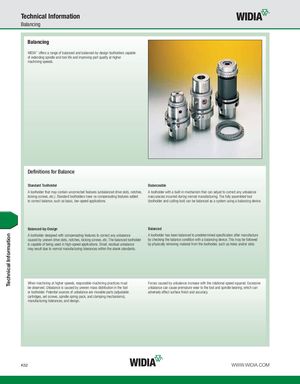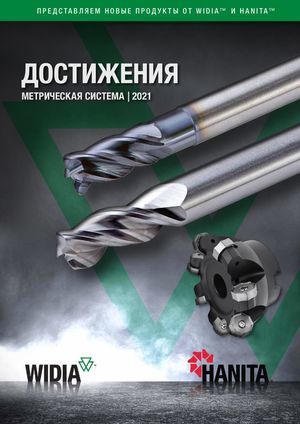Каталог Widia инструментальная оснастка - страница 1088
Навигация

Technical Information Balancing Balancing WIDIA™ offers a range of balanced and balanced-by-design toolholders capable of extending spindle and tool life and improving part quality at higher machining speeds. Definitions for Balance Standard Toolholder Balanceable A toolholder that may contain uncorrected features (unbalanced drive slots, notches, A toolholder with a built-in mechanism that can adjust to correct any unbalance locking screws, etc.). Standard toolholders have no compensating features added inaccuracies incurred during normal manufacturing. The fully assembled tool to correct balance, such as basic, low-speed applications. (toolholder and cutting tool) can be balanced as a system using a balancing device. Balanced-by-Design Balanced A toolholder designed with compensating features to correct any unbalance A toolholder has been balanced to predetermined specification after manufacture caused by uneven drive slots, notches, locking screws, etc. The balanced toolholder by checking the balance condition with a balancing device. This may be followed is capable of being used in high-speed applications. Small, residual unbalance by physically removing material from the toolholder, such as holes and/or slots. may result due to normal manufacturing tolerances within the shank standards. When machining at higher speeds, responsible machining practices must Forces caused by unbalance increase with the rotational speed squared. Excessive be observed. Unbalance is caused by uneven mass distribution in the tool unbalance can cause premature wear to the tool and spindle bearing, which can or toolholder. Potential sources of unbalance are movable parts (adjustable adversely affect surface finish and accuracy. cartridges, set screws, spindle spring pack, and clamping mechanisms), manufacturing tolerances, and design. K52 WWW.WIDIA.COM Technical Information
 Каталог Widia достижения 2021
Каталог Widia достижения 2021 Брошюра Widia решения для аэрокосмической промышленности
Брошюра Widia решения для аэрокосмической промышленности Брошюра Widia техническое руководство
Брошюра Widia техническое руководство Каталог Widia токарный инструмент 2020
Каталог Widia токарный инструмент 2020 Каталог Widia цельные концевые фрезы
Каталог Widia цельные концевые фрезы Каталог Widia техническое руководство по разверткам
Каталог Widia техническое руководство по разверткам